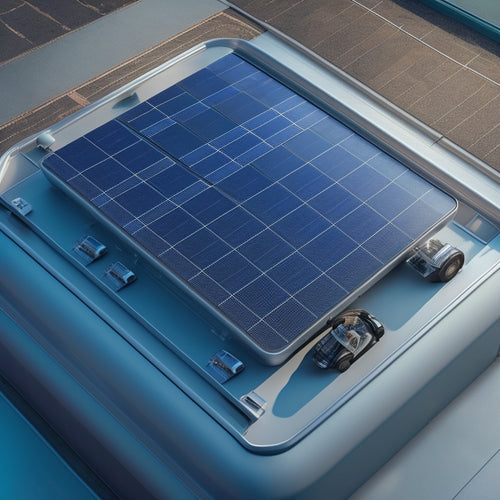
Broken Panel Disposal: A Step-by-Step Recycling Guide
Share
You're about to start on an essential step in guaranteeing the environmentally responsible disposal of your broken panels. To get started, prepare your broken panels for recycling by collecting and sorting them by type, categorizing them by material composition, and storing them in a dry, secure area. Remove non-recyclable components, separate materials, and clean them of contaminants. Then, properly package the panels for transport to a recycling facility. From there, you'll navigate the processes of disassembling, hazardous material management, and component separation. As you continue, you'll uncover the specifics of responsible disposal and recycling methods that ensure a sustainable future.
Key Takeaways
• Collect and sort broken panels by type and material composition, ensuring compliance with local regulations for hazardous waste disposal.
• Disassemble panels carefully, removing non-recyclable components, and separate materials into categories for efficient recycling.
• Identify and handle hazardous materials like lead, cadmium, and mercury with care, following environmental guidelines for safe recycling.
• Package broken panels securely for transport to designated drop-off locations, participating in community recycling events and responsible disposal practices.
• Ensure responsible recycling by separating recyclable components, categorizing materials, and following certifications like ISO 14001 and EPA compliance.
Preparing for Recycling
Before sending your broken panels to a recycling facility, collect and sort them by type, as different materials require separate processing. This vital step guarantees that each component is handled correctly, maximizing the recycling potential. You'll need to categorize panels by their material composition, such as crystalline silicon, thin-film, or organic photovoltaic cells.
Proper storage is essential during this preparation phase. Designate a dry, secure area for storing broken panels, protecting them from environmental factors that could further degrade the materials. Consider using storage options like pallets or containers specifically designed for broken solar panels. This will prevent damage during transportation and facilitate efficient processing at the recycling facility.
Remember to comply with local regulations and guidelines for hazardous waste disposal. Ensure you're meeting regulatory compliance standards for broken solar panel disposal in your region.
Disassembling the Solar Panel
Disassembling the solar panel requires careful removal of the frame, junction box, and electrical connections to access the photovoltaic cells and other recyclable materials. You'll need specialized Panel Tools, such as screwdrivers, pliers, and wrenches, to disassemble the panel efficiently. Before starting, take necessary Safety Precautions: wear protective gloves, safety glasses, and a dust mask to guarantee safety from injury due to broken glass or electrical shock.
Begin by removing the frame, which typically involves unscrewing or unbolting the aluminum or anodized frames. Next, disconnect the electrical connections, taking care not to touch any exposed wires. Remove the junction box, which houses the electrical connections, and set it aside for further disassembly.
Continue to disassemble the panel, carefully removing the photovoltaic cells, wiring, and other components. As you disassemble, sort the materials into separate categories, such as metals, glass, and plastics, to facilitate the recycling process. Remember to handle the materials with care to prevent damage and ensure a successful recycling process.
Removing Hazardous Materials
Identifying hazardous materials, such as lead, cadmium, and mercury, in the disassembled panel components is vital to prevent environmental pollution and ensure safe recycling. You'll need to pinpoint these toxic substances and separate them from the rest of the materials. This is an essential step, as improper disposal of hazardous materials can contaminate soil, water, and air, posing serious risks to human health and the environment.
Toxic substance identification is pivotal in this process. You'll need to inspect the panel components carefully, looking for labels or markings that indicate the presence of hazardous materials.
Once you've identified these substances, you'll need to handle them according to environmental policy reform guidelines. This may involve storing them in designated containers or facilities until they can be properly disposed of.
Separating Recyclable Components
You'll separate the recyclable components, such as copper, aluminum, and glass, by categorizing them based on their material type and condition. This step is vital in maximizing the recyclable value of your broken panel.
As you sort, create distinct material streams for each type of material, ensuring that similar materials are grouped together. This will facilitate efficient processing and minimize contamination.
To guarantee accurate component tracing, label each material stream clearly, indicating the material type and any specific processing requirements. For instance, if you have a stream of copper wiring, label it as 'Copper - High-Temperature Processing Required.' This attention to detail will help you and the recycling facility to efficiently process the materials.
Remember to handle components carefully to prevent damage, which can reduce their recyclable value. As you separate the components, keep in mind that the goal is to create pure material streams that can be easily processed and transformed into new products.
Responsible Disposal Methods
When preparing to dispose of your broken panel, it's crucial to contemplate responsible disposal methods to minimize environmental harm.
You'll need to identify drop-off locations that accept electronic waste, properly package the broken panel to prevent damage during transport, and potentially participate in community recycling events.
Drop-off Locations
Take your broken panel to one of the designated drop-off locations, where it will be recycled in an environmentally responsible manner. You'll find these locations conveniently situated near you, guaranteeing minimal disruption to your daily routine. Convenience factors, such as extended operating hours and easy accessibility, are carefully considered when selecting drop-off locations. This guarantees that you can easily dispose of your broken panel at a time that suits you.
Rural accessibility is also a key consideration, with many drop-off locations strategically placed to cater to rural communities. This ensures that everyone, regardless of their location, has access to responsible disposal methods. You can simply enter your zip code or location into an online search engine to find the nearest drop-off location. A detailed list of authorized drop-off points is also available on local government or recycling websites.
Proper Packaging Methods
Before dropping off your broken panel, make sure it's properly packaged in a sealed, sturdy box to prevent damage during transportation and handling. You want to guarantee that your broken panel arrives at the recycling facility in the same condition it left your hands. Proper packaging is essential to preventing further damage and ensuring a smooth recycling process.
To package your broken panel correctly, follow these steps:
-
Use a custom box: A box specifically designed for your broken panel's size and shape will provide the best protection.
-
Wrap it in Bubble Wrap: This will cushion your panel and prevent scratching or shattering during transport.
-
Seal the box securely: Use packing tape to close the box and prevent it from opening during transport.
- Label the box clearly: Mark the box as 'Fragile' and 'Broken Electronics' to make sure handlers take extra care.
Community Recycling Events
You can responsibly dispose of your packaged broken panel at community recycling events, which are often organized by local governments, waste management companies, and environmental groups. These events provide a convenient and environmentally friendly way to recycle your broken panel.
To find a community recycling event near you, check your local government's website or social media pages for event promotion and schedules.
At the event, volunteers will guide you through the recycling process, making sure that your broken panel is disposed of responsibly. Effective volunteer management is vital to the success of these events, as it ensures that the recycling process runs smoothly and efficiently.
Recycling Facility Options
Three primary recycling facility options exist for broken panel disposal: municipal facilities, private recycling centers, and community drop-off locations. When choosing a facility, consider factors such as convenience, cost, and environmental impact. You'll want to select a facility that aligns with your values and recycling goals.
Before making a decision, research the facility's regulations and environmental standards. Make sure the facility is equipped to handle broken panels and follows responsible recycling practices.
You can ask questions like:
- What types of materials are accepted?
- Are there any preparation requirements for the broken panels?
- What's the facility's recycling rate for similar materials?
- Are there any certifications or compliance with environmental regulations?
Frequently Asked Questions
Can I Recycle a Broken Solar Panel From My Home?
You can recycle a broken solar panel from home, promoting energy efficiency and responsible home storage practices, but first, make sure you follow local regulations and guidelines to properly dispose of the hazardous materials.
How Do I Handle Sharp Broken Glass From the Panel?
When handling broken glass from your solar panel, you'll need to prioritize Glass Safety to avoid Cutting Hazards. Wear protective gear, including gloves and safety glasses, to minimize risks and guarantee a safe disposal process.
Can I Reuse Components From a Broken Solar Panel?
'Imagine a treasure trove of reusable goodies! You're wise to contemplate component harvesting from your broken solar panel. Refurbishment is possible, but beware: contamination risks and electrical mismatches may render harvested parts useless - proceed with caution.'
Are There Any Tax Incentives for Recycling Solar Panels?
You'll be pleased to know that yes, there are tax incentives for recycling solar panels, including corporate benefits and government subsidies, which can help offset recycling costs and promote sustainable practices within your organization.
Can I Recycle a Solar Panel That's Still Under Warranty?
You should review your warranty details to understand the manufacturer's policy on recycling or repairing a still-under-warranty solar panel, as it may impact your warranty status or require specific procedures.
Related Posts
-

Why Invest in Solar Car Battery Chargers Online?
By investing in a solar car battery charger online, you're not only reducing your reliance on fossil fuels but also o...
-

Top Solar Panels for Car Battery Maintenance
When selecting top solar panels for car battery maintenance, consider high-efficiency models with high wattage output...
-

Solar Power Units Perfect for Homes
You're considering installing a solar power unit in your home, a decision that can notably reduce your reliance on tr...


